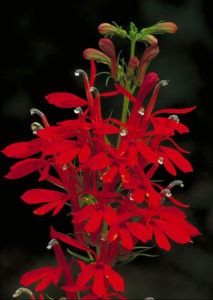
The cardinal flower (Lobelia cardinalis) is a native Kentucky wildflower that grows in moist to wet woods and stream banks. Typically it only grows 2-4 feet tall, but it can grow as tall as 6 feet if it is in really rich, wet soil. Cardinal flower does not do well in dry conditions and will quickly die if it dries out.
From late June through September, cardinal flower produces spikes of brilliant red flowers. The red is unlike any other red I’ve seen on a native wildflower. It is absolutely spectacular. The stalk starts blooming from the bottom and the flowers work their way to the top. A single stalk can be in bloom for several weeks.
The name cardinal flower has nothing to do with the bird called the cardinal. Instead the name refers to the bright red cloaks that Catholic Cardinals wear. Apparently when the flower was taken to England as an ornamental in the 1600s, the bright red flowers reminded people of a Cardinal’s robe. Thus the common name of cardinal flower was born.
Cardinal flowers are highly attractive to hummingbirds. In Kentucky, the ruby-throated hummingbird is its primary pollinator. The pollen from the cardinal flower is deposited on the top of the hummingbird’s head as it sips the nectar. The pollen is then transferred to the next flower when the hummingbird moves to another flower. Cardinal flowers can be especially important to hummingbirds getting ready to migrate south in the fall.
Butterflies and a few species of long-tongued bees will also use cardinal flower to varying degrees. However, the shape of the flower and the length of its corolla (flower tube) make it difficult for most bees to work the flowers. In addition, most bees don’t recognize the color red.
Cardinal flowers can be grown in a pollinator garden to attract hummingbirds. Most of the native plants nurseries in the state, including our Busy Bee Nursery, sell cardinal flowers. The seeds are like dust and require moist stratification for 3 months, so purchasing plants is probably the best bet for most people. The first year, cardinal flower will produce a leafy roseate. It typically doesn’t bloom until its second year.

When planting cardinal flower, make sure you plant it in a moist to wet area that never dries out. It doesn’t like to be crowded or to be covered over in the winter. Cardinal flower will produce small, leafy off-shoots at the base of the plant. The leafy off-shoots need to remain uncovered during the winter. Several reports state that when the leafy off-shoots are covered by leaves or mulch they are more likely to die than plants where the leafy off-shoots are uncovered. It is thought that the off-shoots may continue to produce food for the plant on warm, sunny winter days.

This article was part of Shannon’s original Kentucky Pollinators and Backyard Wildlife blog which evolved into the blog for Backyard Ecology.

Backyard Ecology: Exploring Nature in Your Backyard
Nature isn’t just “out there.” It’s all around us, including right outside our doors. Hi, my name is Shannon Trimboli, and I am the host of Backyard Ecology. I live in southcentral Kentucky and am a wildlife biologist, educator, author, beekeeper, and owner of a nursery specializing in plants for pollinators and wildlife conservation. I invite you to join me as we ignite our curiosity and natural wonder, explore our yards and communities, and improve our local pollinator and wildlife habitat. Learn more or subscribe to my email list at www.backyardecology.net.

Leave a Reply